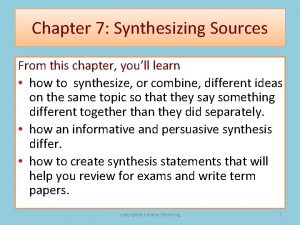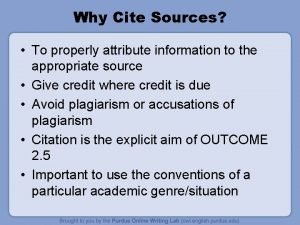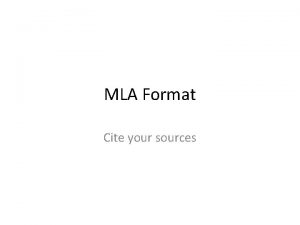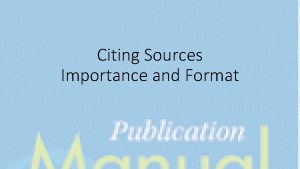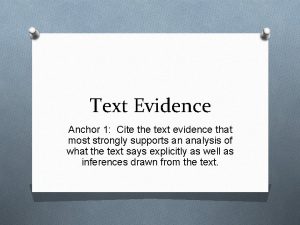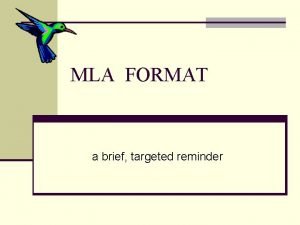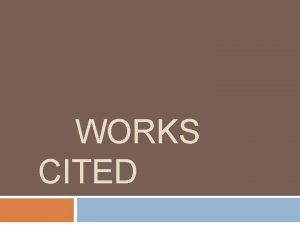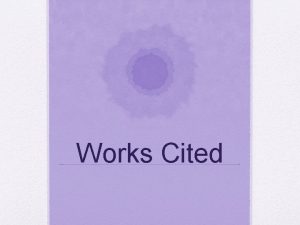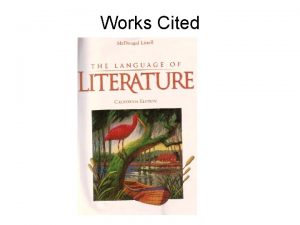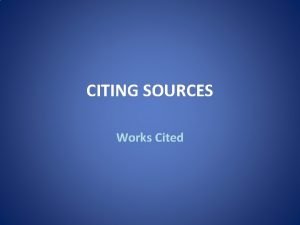Citing Sources in text and on Works Cited








- Slides: 8

Citing Sources in text and on Works Cited Page

�A source is any publication or material that will aide you in your research. � Examples include, but are not limited to: books, newspapers, magazines, academic journals, encyclopedias and references books, interviews, websites, etc. � There are two types: primary and secondary (we will be discussing the difference later in the year) � You are NOT allowed to use Wikipedia, Spark. Notes, Yahoo Answers, Wiki Answers, Cha, Schmoop, KGB. com, or any similar sites as a source in a research project.

� � � Open Microsoft Word Set margins for 1” on all sides Insert a header, justified to the right The header should be your last name and page number of the essay � Header should be ½” from the top of the page � � Set paragraph spacing to double or 2. 0 � � It’s usually already set-up like that Go to “insert, ” click “header, ” click “page #” to the right and type in your last name, click “close header & footer. ” On “home, ” go to “paragraph” section and select 2. 0 from the line spacing Set the font to 12 pt, Times New Roman On the first line, justify to the center and type “Works Cited” Push enter once, justify to the left, and begin entering your sources alphabetically by author If there is no author, go by the title of the book/website page � If a source goes beyond one line, indent the second line by ½” �

Name of the author 1. 1. 2. Last name, first name (Metcalfe, Clayton G. ) Period after the first name/middle initial Title of the work 2. 1. 2. Italicize the title when typing it Period after the title Edition Used Numbers of the volumes used City of Publication, followed by a colon “: ” Name of Publisher, followed by a comma Year Published, followed by a period Medium of publication consulted, followed by a period 3. 4. 5. 6. 7. 8. 1. Print. Metcalfe, Clayton G. How to scare High School English Students on the First Day of School. Boston: Scholastic, Inc. , 2011. Print.

Name of the author (if signed) 1. 2. 3. Last name, first name (Metcalfe, Clayton G. ) Period after the first name/middle initial If unsigned, go right to title of entry Title of the entry in quotation marks, followed by a period INSIDE the quotation marks Title of the Encyclopedia, italicized, followed by a period. Edition Used, followed by a period “ 15 th Ed. ” or “ 15 th Edition. ” Numbers of the volumes used, followed by a period “Vol. 4. ” or “Volume 4. ” City of Publication, followed by a colon “: ” Name of Publisher, followed by a comma Year Published, followed by a period Medium of publication consulted, followed by a period 2. 3. 4. 5. 6. 7. 8. 9. 1. Print. Metcalfe, Clayton G. “Athena. ” Encyclopedia of the Weird and Awesome. 15 th Ed. Vol. 4. Boston: Publishing House, Inc. , 2011. Print.

Name of the author (if applicable), followed by a period 1. Title of the webpage, followed by a period 2. 1. Italicize the title of the webpage if it is an independent site 2. Use quotes if the webpage is part of larger site Title of the “mothership” website, followed by a period 3. 1. 2. If the title of the webpage is italicized, then don’t do anything to the font for this one If the title of the webpage is in quotes, italicize the title of the mothership website Date of publication (day, month, year), followed by a period. 4. 1. 26 Oct. 2011 or 26 October 2011. Medium of Publication, followed by a period 5. 1. Web. Date of Access, same format, followed by a period 6. URL of website inserted in angle brackets, followed by a period 7. 1. <URL>. 2. If it goes onto more than one line when you type in the URL on your Works Cited page, split the citation only after a double or single dash Metcalfe, Clayton G. “How to teach good and learn good too. ” Grammar Mistakes of High School English Classes. 26 Oct. 2007. Web. 26 Oct. 2011. <http: //www. grammar. org/mistakes/teachingandlearning>. Grammar Mistakes Students Make. Grammar. org. 26 Oct. 2007. Web. 26 Oct. 2011. <http: //www. grammar. org>.

� When citing a book within your essay, follow this format: � If the author’s name is mentioned in the sentence before or after inserting the quote, use only the page number inserted in parentheses Metcalfe discussed this thoroughly when he stated: “Students will make all kinds of grammatical mistakes…If you let them. ” (64) “Students will make all kinds of grammatical mistakes…IF you let them. ” Metcalfe could not be more clear about the importance of grammar in the classroom with his statement. (64) � If the author’s name is not mentioned in the sentence, follow the quote or paraphrasing with the author’s last name and page # in parentheses Grammatical mistakes occur only when a teacher is too lazy to correct the students. “Students will make all kinds of grammatical mistakes…IF you let them. ” (Metcalfe 64) There are some who believe that the only reason students make grammatical mistakes is because their teachers allow them to and fail to correct them. (Metcalfe 64 -65)

� When citing an encyclopedia within your essay, follow this format: �Title of entry in quotation marks, followed by page # �In parentheses (“Athena” 72) � When citing a website within your essay, follow this format: �Title of webpage and page # if applicable �In parentheses (grammar. org)
